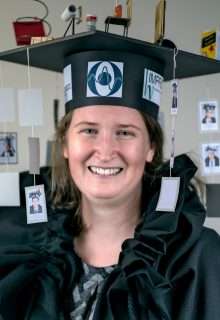Lina Felsner
Advanced 3-D Reconstruction of Talbot-Lau Data
X-ray imaging is a standard technique for examinations and interventions in medicine. Based on X-rays, Phase-Contrast Imaging (PCI) can provide an excellent soft-tissue contrast. The most promising setup for measuring phase-contrast in a medical context is the Talbot-Lau Interferometer (TLI), where specialized gratings are integrated between a regular medical X-ray tube and X-ray detector. The TLI allows to measure the classical X-ray attenuation in combination with the phase-contrast and dark-field signal. All three signals provide unique information and can in combination with each other enable an improved medical diagnostic. Acquiring volumetric scans with a TLI enables multi-modal imaging in which the reconstructed volumes are inherently registered. While medical procedures could greatly benefit from such a system, current implementations of such a setup in a medical environment are prevented by hardware- and software-based problems. In this work, we propose algorithms for solving algorithmic challenges towards the reconstruction of phase-contrast and dark-field signals with clinical compatibility.
In the first part, advanced reconstruction techniques for the differential phase-contrast signal from a TLI are investigated. Here, the focus is on improving the reconstruction of the phase contrast data from a TLI for large objects. Current Talbot-Lau systems suffer from a small field of view, which leads to truncation for large objects, such as humans. To avoid artifacts in the reconstruction, we propose a method for phase-sensitive Region-of-Interest (ROI) Computed Tomography (CT). The proposal involves a special setup, where a large detector allows measuring complete non-truncated attenuation images, while additional gratings allow for phase-contrast imaging of a ROI. A corresponding correction algorithm is proposed to correct the truncation of the phase-contrast images. With experiments, we show that the proposed method can enable a clinically practical TLI implementation. Unfortunately, the signal strength of the phase measurement depends on the position of the object in setup. This leads to a change in the projection model and subsequent artifacts in the reconstruction. The artifacts prevent the evaluation of quantitative values and, therefore, the use of the data in a medical environment. In particular, this challenge introduces artifacts in the reconstruction of large objects. We propose two correction algorithms to alleviate this issue. The excellent performance of both algorithms in the experiments indicate the possibility for phase-sensitive CT for large objects.
In the second part we consider the reconstruction of the dark-field signal. The scattering of the dark-field signal is high-dimensional, which leads to an orientation-dependent signal strength and prevents the use of Filtered Back-Projection (FBP) algorithms. Current projection models describe the signal formation only in two dimensions. Therefore, in order to reconstruct the dark-field, complex sampling trajectories must be used, which are clinically impractical. To tackle this challenge, we propose a general 3-D dark-field projection model, which enables to model the signal formation directly in 3-D. The general description facilitates a high degree of flexibility and enables modeling complex trajectories such as a helix. Our experimental evaluation shows a good agreement with wavefront simulations and real measurements. The projection model also allows a reconstruction of the dark-field signal with a true 3-D dark-field reconstruction algorithm. Experiments show the feasibility of a helical reconstruction and investigated the stability of the algorithm with respect to different influences. Overall, these promising first results indicate that a reconstruction of directed structures with a spiral trajectory is feasible.
